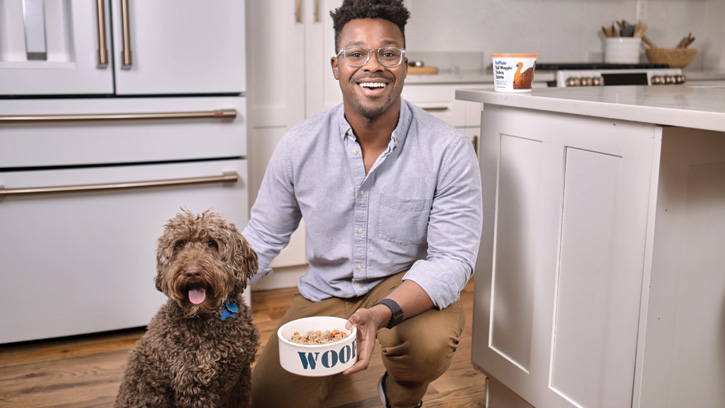Startups Woo Pet Parents Via E-Commerce
Startups & Innovators | INNOVATION
As the pandemic took hold in 2020, sales of traditional CPG brands clawed back share from startups as consumers sought out comfort foods. But in the pet food category, entrepreneurs found firmer footing as millions of Americans became pet owners and gave newer, health-oriented brands a shake—including a few that rode home delivery and online subscriptions to rapid growth.
What’s happened in the post-pandemic era has only strengthened the hand of these pet food startups, as pet owners largely have held on to their canine and feline friends, and many have gotten comfortable paying premium prices for the most nutritional fare. The next stress point could be a recession, however.
“It’s extremely inelastic demand,” says Renaldo Webb, an MIT graduate who worked as a consultant before founding his own whole-food brand, PetPlate, in 2015. Since then he has built it to annual revenues of $10 million or more, with expectations of doubling that total this year.
“During the Great Recession, people were bringing pets back to shelters. But now it’s more like parents almost taking care of their kids. They aren’t giving them up,” says Webb.
Scott Lerner, former chief executive officer of Better Choice Co. and its Halo dog food brand, notes that “11 million new ‘COVID puppies’ were added to the industry, and those dogs haven’t gone away. They need to be fed.”
Record-Setting Sales
Americans spent $50 billion on pet food and treats in 2021, the fastest-growing CPG category, with a 13.6% increase over 2020, according to the American Pet Products Association. Overall pet industry sales reached $124 billion in 2021—the second consecutive record-setting year for the industry.
Experts expect that strength to continue. “We see continued interest in premium and human-grade options,” says Nicole Hill, executive director of strategy for MarketPlace, a strategy firm that advises pet food brands. “Consumers may be tightening their belts in certain ways, but household income doesn’t have a direct relationship to the amounts people are willing to pay for their pets the way it does in other categories.”
Halo and PetPlate have proven that premium positioning, home delivery, and getting pet owners to sign up for subscriptions can work well in their industry just as such approaches have been overtaking other categories via e-commerce. Webb says online pet food giant Chewy.com, now owned by retailer PetSmart, “was a darling during the [pandemic] bubble, and the trajectory for them is still strong. Pet food is heavy and people want to do what’s best for their pets, but they don’t want to have to [think] about it.”
After striking out on Shark Tank a few years ago, PetPlate successfully nabbed $100,000 from a friends and family round, then in 2020 managed to score a $9 million Series A investment in a round led by General Mills’ venture capital division, followed by $19 million in Series B funding late in 2021. It charges from about $150 to about $400 a month for extremely carefully concocted human-grade pet food products made out of whole meats and vegetables in U.S. Department of Agriculture–approved facilities, delivered to customers’ doorsteps—making it what Crunchbase called the “Blue Apron of pet foods.”
“I would argue that pet food is one of the best subscription businesses you can think of,” Webb says. “We do extremely well with our retention rate compared with Blue Apron and with human- and beauty-based subscription products.”
Premium Formulations
And many canines’ diets actually require picky food. “There might be a misconception that this is a nice-to-have product,” Webb says. “But if a dog has a sensitive stomach, your options may be finding kibble with worse ingredients, or cooking for your dog. There’s a limited set of options. And once you find something that works, the reasons to leave just aren’t that many as long as you can continue to afford it.”
Better Choice, a publicly traded company founded in 1986, also competes in the superpremium segment of the market but with its Halo brand of dry kibble—“everything $70 and above is where we play,” Lerner says. “Our target consumer is a millennial, a pet parent to the extreme, who treats their pets like kids and wants to give them the best nutrition possible.”
While Halo sells via its own website and through Amazon, with about half its revenues coming from recurring-revenue subscriptions, the brand also is distributed in bricks-and-mortar outlets such as the Petco chain.
The strength of their business models—subscriptions, top-notch nutrition, and robust relationship-building with existing and new customers via social and other digital media—has helped both companies weather big price increases over the last year that they have passed along because of the inflationary pressures in their supply chains.
“If you raise the price $2, consumers don’t want to deal with issues they might create with GI issues for their dog, for example,” Lerner says. “That’s why it’s so important to acquire the right consumer and maintain them going forward. It’s like an annuity: Invest up front and gain all the volume on the back side.”


